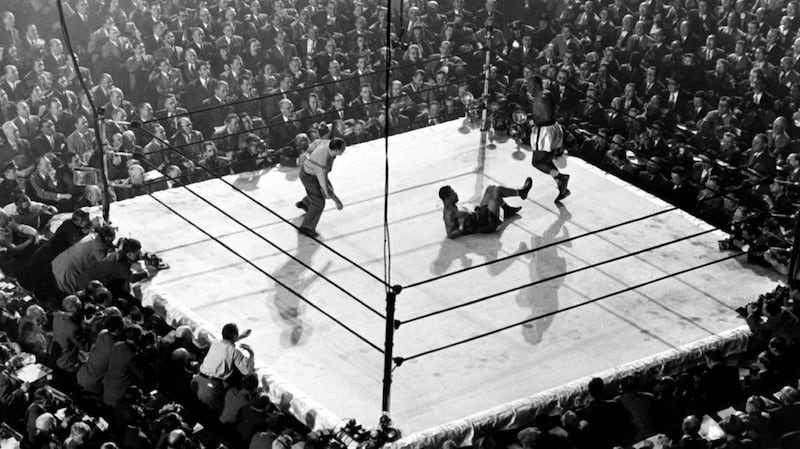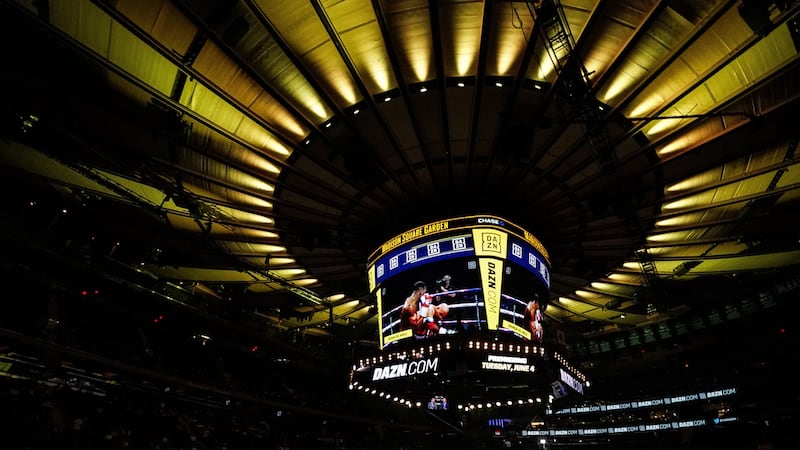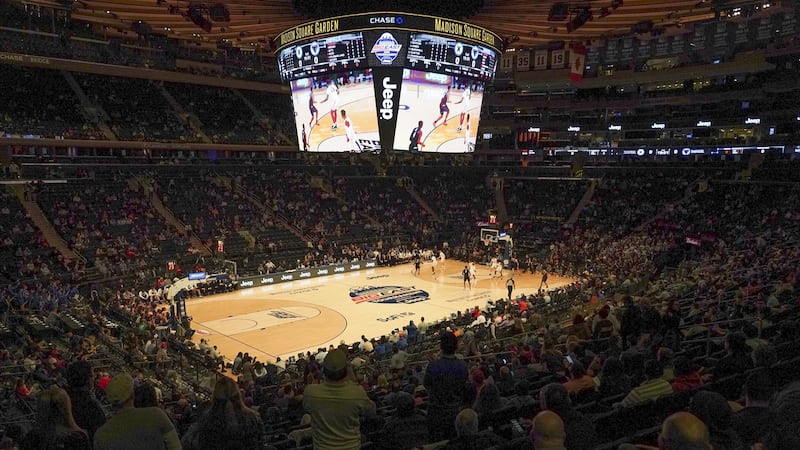For a few minutes on the night of April 25th 1999, it was just me and Patrick Ewing left in the Knicks’ locker room in Madison Square Garden. All the others had gone. It was quite a moment – though possibly for me more so than him.
This was about an hour after an exhilarating 82-80 win over Tim Hardaway’s Miami Heat. The famous arena off Eighth Avenue had been raucous in a way it hadn’t been all season. Ewing was spent: he had sat beside his locker for over half an hour still in his shorts and singlet soaking his aching knees in huge plastic bins filled with iced water. He has this extraordinary long chiseled face which is always slightly subdued in repose and he sat back that night observing as the younger team mates did their media duties before giddily disappearing quickly into the night. He remains the most enormous human being I’ve ever seen up close. He was only 36 that night but basketball years are like dog years: you age differently.
And since 1984, Ewing had been carrying the hopes of the basketball mad boroughs on his shoulders. This was just a year after Michael Jordan had retired and the NBA season was drifting through the black hole created by his departure: there was a thin opportunity for the Knicks to win a championship that was up for grabs. Ewing was the veteran of a high octane, unpredictable team. To my immense disappointment, John Starks, my favourite player because he never backed down from Jordan, had been traded in January. Now the Knicks had the silky Allan Houston, who answered questions with the suavity of a future politician, the combustible Latrell Spreewell – Starks’ replacement – who wore his trademark multi-coloured sweater and Marcus Camby, who stood a slimby 6’11’ and wore, on the evening, a shimmering silver suit. This was a Thursday in the roaring years of Clintonian optimism.

And it was my first time in Madison Square Garden. I wasn’t long working for The Irish Times and had been kindly volunteered by Seán Moran, the GAA correspondent, to ‘cover’ an Irish Defence Forces football trip to play New York because it clashed with annual congress, which he was duty-bound to attend. All I remember about that match, played in Gaelic Park, was that Jim Gavin excelled in what resembled an hour of legalised mixed martial arts. New York were decent and preparing for their inaugural Connacht championship visit: it was a proper contest.
I’d arranged to attend the Knicks game with my friend Liam Travers, who was (and still is) 6’7” and himself a ball player – then living in New York. Obtaining tickets wasn’t a problem but I remembered that I was supposed to be a ‘journalist.’ What if I requested accreditation? I’d no idea how you did this. But I’d had a few beers and I called the operator from a payphone and got a number for the NBA’s head office, which was in New York. I was somehow patched through to Brian McIntyre, then the head of PR for the NBA, a highly obliging guy and, as his name suggests, no stranger to Irish lads chancing their arm. He said as long as the office in Dublin faxed through a request on headed paper, it was no problem. A few hours later, I was, to my disbelief, picking up accreditation and sitting in a small room watching Jeff van Gundy, then the Knicks head coach, talk in that fast, interested vaguely combative way of his.
I’d lived in Boston and was lucky enough to see the Celtics play in the old, long-since-razed Boston Garden, which remains my favourite ever arena for the sheer charisma of the place: if you were to pair sports arenas to actors, the shambolic red-eyed pile on Causeway would be Humphrey Bogart. But to breach the inner sanctum of the Knicks with a quick phone call felt like some kind of brilliant trick. The game was a thriller. The local crowd was, as promised, loud and judgmental and enthusiastic whenever the in-house cameras closed in on the celebrities. And although I had read of the access afforded to the media – in the locker before the game and again afterwards – it was still staggering to observe it up close. I ended up wandering through the corridors of the arena catching glimpses of the famous floor through various doorways. Eventually I rambled out. Nobody paid a blind bit of notice because of the laminate on my neck and security was very relaxed anyhow.
At one stage, I walked across the court behind the basket and saw a tall, sharp suited guy who was clearly a former ball player and whose face I recognised at the same time as a guy sweeping between the seats behind the basket who jauntily shouted “Walt-F**ken-Frazier” and got a wave for his troubles. Empty of people, the arena looked a marvel.
Madison Square Garden bills itself “the world’s most famous arena” but of course that’s just New York chutzpah and egocentrism: it’s the best because its theirs, right? The place has already had four incarnations and the construction of the current version, in 1968, was an architectural scandal, requiring the demolition of the ‘original’ Pennsylvania Station, the pink-tinted wildly ambitious beau-vieux dream that had fallen out of fashion and into neglect by the 1960s. It took a full three years to rip it down and the big dome-shaped Garden was crudely plonked down on top of the train station, which has felt cramped and cave-like ever since. There is nothing lovely about Madison Square Garden and nothing hip or elegant. It cannot hope to match the hauteur of Wimbledon or the authenticity of Anfield or the sense of rich melancholy glory that shrouds the Maracana. All it’s really got going for it is a glowering machismo and the self-assurance that comes with being New York’s home of entertainment.

Ali-Frazier; Lennon; Sinatra, the Pope, Elvis, Ted Kennedy’s concession speech (“the cause endures and the dream will never die”), Jordan, Springteen and the immortal Knicks team of 1973: the place reeks of accomplishment. All the local rock gods have played there – except the Ramones, who turned it down.
On one level, Madison Square Garden is simply the city’s most visible and gaudy symbol of commerce. It’s a cash cow, constantly relieving willing visitors of their dollars; of turning over the replica Knicks sweatshirts made iconic by Joey in Friends; of paying for comically overpriced beers and hot-dogs and of knowing you are being huckstered but nor really minding. But for all of that, it is Madison Square Garden. The name evokes the promise of magic. Even the great artists know they’ve crested something when they play there. When the sports broadcasts open with an exterior, aerial shot of the building, it feels like the epicentre: that whatever is happening elsewhere is merely a sideshow.
So when I wandered in a daze back to the Knicks locker room that evening, I found it deserted except for Mr Ewing, who was by then in a suit and ready to leave. Ewing registered my presence. He asked where I was from and nodded as if well used to unprompted visits from the Irish. I couldn’t understand why I wasn’t being turfed out by security guards but the place seemed deserted, as if they had all tired of waiting for the big guy to get dressed and had asked Ewing to lock up on his way out. Out of professional courtesy I suggested an interview – not having with me pen, paper, dictaphone or anything that remotely resembled the tools of journalism. He considered the request for a good half second, breathed deeply and said “Nah, man, I’m all done. Good night.” And he shuffled wearily out.
Any other time I went to see a basketball game in Madison Square Garden, it was as a person rather than as a journalist. Getting lost in the crowd is still the only true way to see sport. On February 26th 2005 I was there with my brother when Reggie Miller made his penultimate appearance with the Indiana Pacers. The game was so-so. When we came out, it was close to 11 and we found the city blanketed in snow, eerily free of cars and extraordinarily white and beautiful. We walked from Eighth Avenue to a bar on Third where my friend Brian then worked. That walk debunked the old myth of the city that never sleeps. Maybe on Friday and Saturday night but on this Thursday, Manhattan was true to Richard Yate’s haunting description of the “faint, faint sound of millions.”

The streets were ghostly and most of the bars forlorn. I was there in recent years to see playoff games with my father (against the Celtics) and my son (the Pacers again) and it was clear how much the NBA had changed. Tickets were like gold dust and the experience was slick and commercial and, in between the interminable television breaks, pathologically concerned with providing entertainment. There was an element of the show about it. Pat Ewing was there that night also, sitting courtside with Starks who now works in the Knicks front office. Now, media requests flood in from all over the world: their wait list is long. Attending the Knicks, even though they’ve been disastrous for most of the past decade, is a tourist attraction, which dilutes the noise of the year round fans. The teams and coaches change.
What you are ultimately experiencing is Madison Square Garden. It’s now the oldest arena in the NBA and the only one not named after a sponsor. And it’s as much an idea as a physical place. The best moment is probably walking up the steps for an early evening game when the sky is changing and the traffic antsy and the offices are just shut and there’s a quickening, an urgency of millions of people on the move at once. And you hear the hawkers offering tickets at outrageous prices and the merchandise sellers and you walk up the flat steps to the best thing about the building: the plain, understated entrance with the name in white capital letters which, for first timers, serves as both a thrilling greeting and an admonishment, a sort of where-have-you-been-all-this-time and would-you-rather-be-anywhere-else.






















